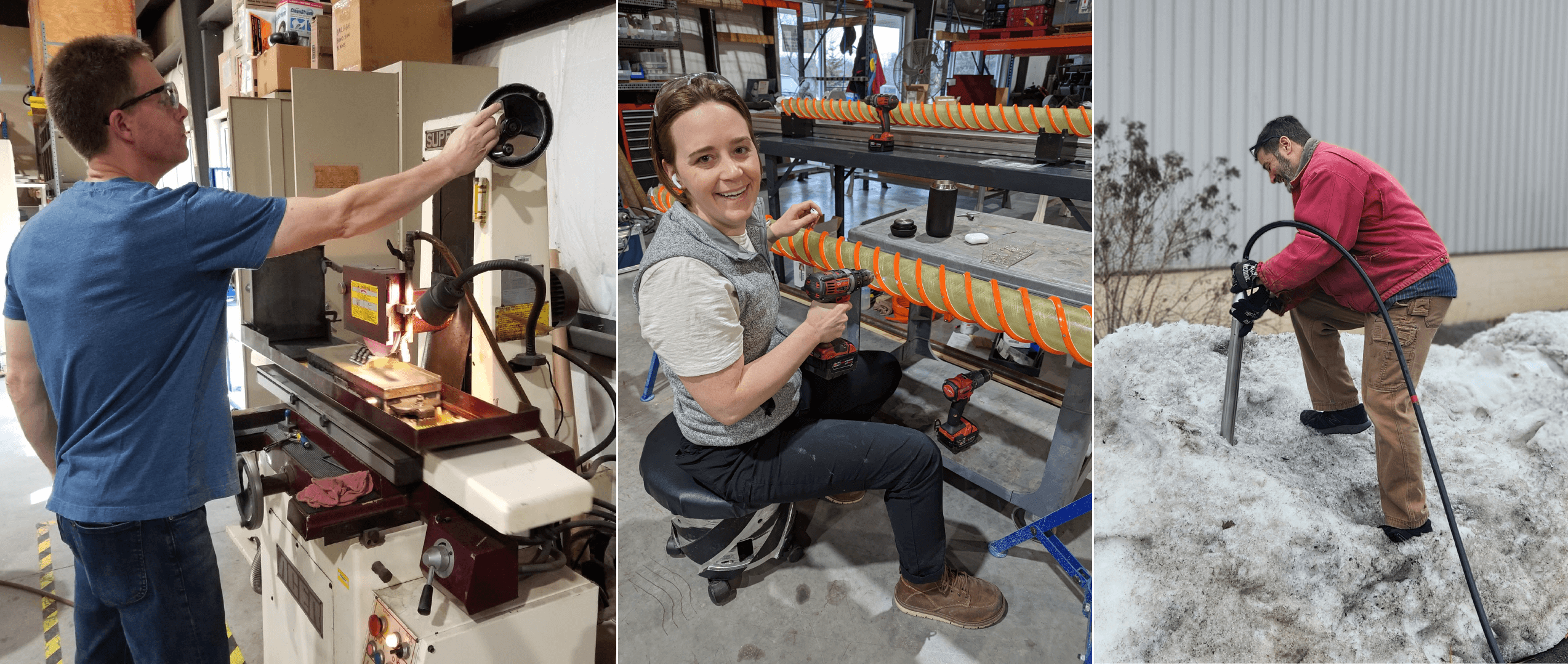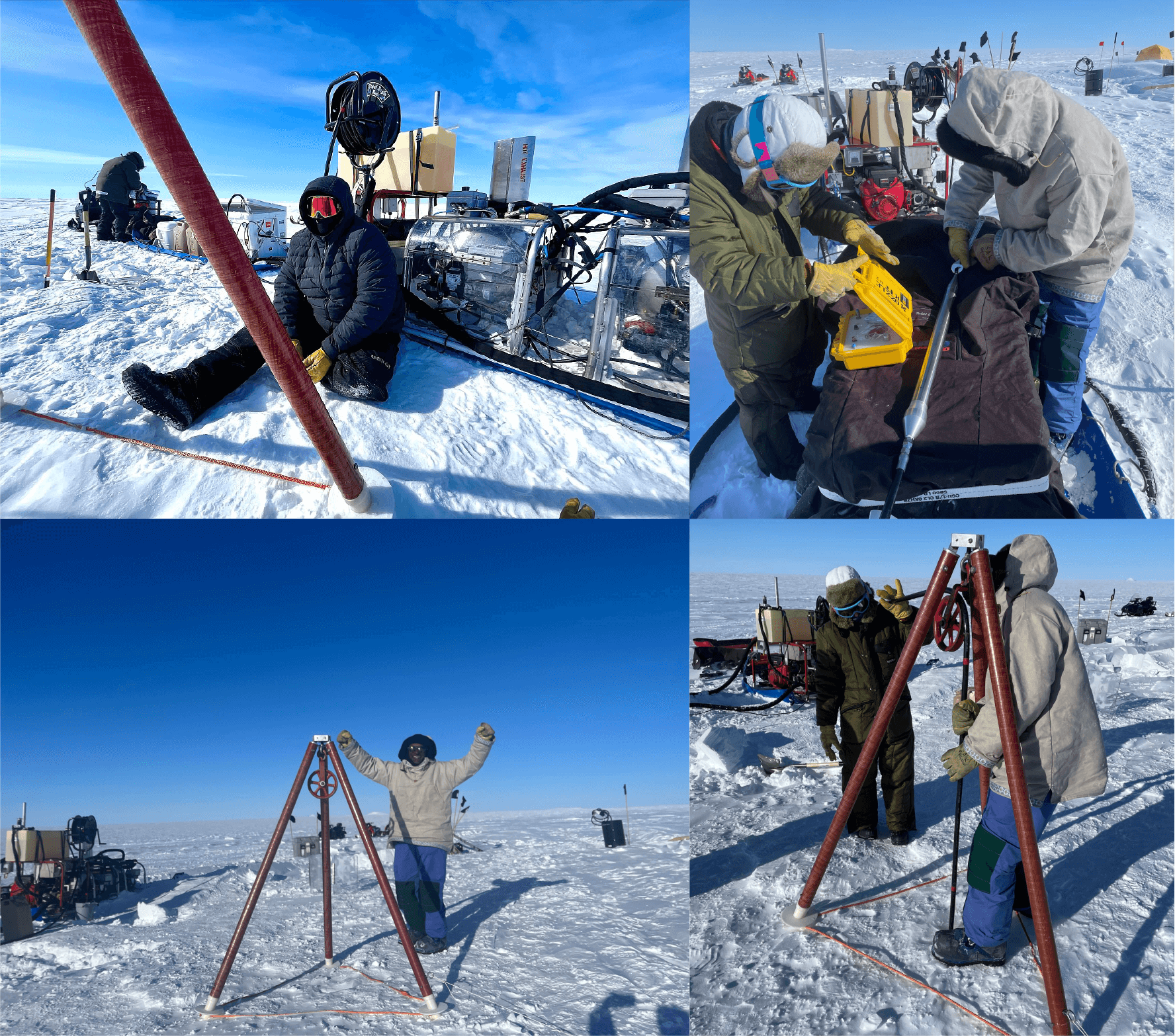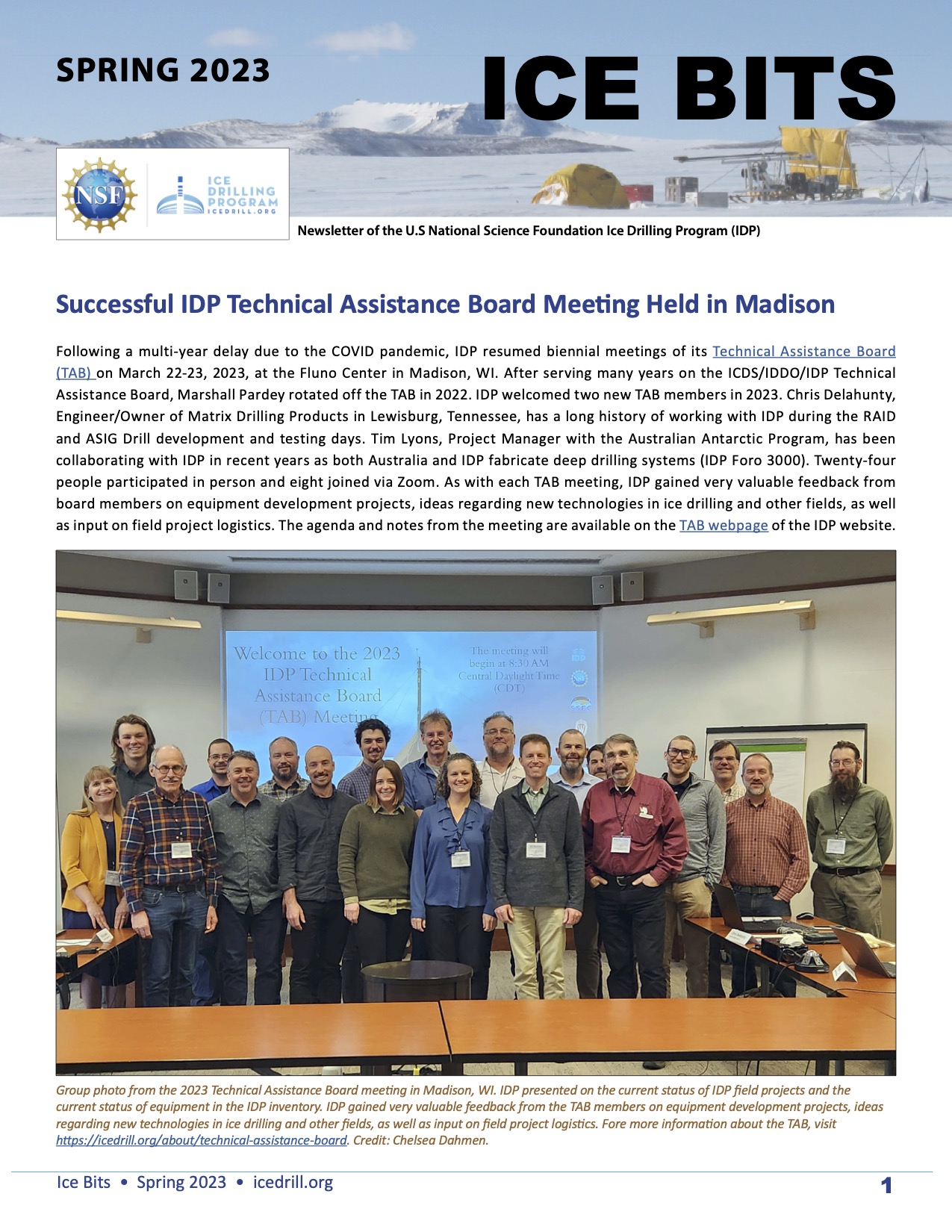Successful IDP Technical Assistance Board Meeting Held in Madison
- Technical Assistance Board
- Meetings/ Workshops
Following a multi-year delay due to the COVID pandemic, IDP resumed biennial meetings of its Technical Assistance Board (TAB) on March 22-23, 2023, at the Fluno Center in Madison, WI. After serving many years on the ICDS/IDDO/IDP Technical Assistance Board, Marshall Pardey rotated off the TAB in 2022. IDP welcomed two new TAB members in 2023. Chris Delahunty, Engineer/Owner of Matrix Drilling Products in Lewisburg, Tennessee, has a long history of working with IDP during the RAID and ASIG Drill development and testing days. Tim Lyons, Project Manager with the Australian Antarctic Program, has been collaborating with IDP in recent years as both Australia and IDP fabricate deep drilling systems (IDP Foro 3000). Twenty-four people participated in person and eight joined via Zoom. As with each TAB meeting, IDP gained very valuable feedback from board members on equipment development projects, ideas regarding new technologies in ice drilling and other fields, as well as input on field project logistics. The agenda and notes from the meeting are available on the TAB webpage of the IDP website.
Drill Maintenance and Testing in Full Swing at IDP-WI
- Hand Auger
- Blue Ice Drill (BID)
- Small Hot Water Drill
IDP engineers worked efficiently during the second quarter to repair and test equipment returned from Antarctic field projects before quickly shipping the equipment to Scotia, NY, for projects in Greenland.
IDP EO Planning Two Summer Workshops and Hires New EO Specialist
- Education/ Outreach
- Meetings/ Workshops
Two workshops are planned for Summer 2023: School of Ice at Dartmouth in June and Virtual Field Labs - Training the Trainers at the NSF Ice Core Facility in Denver in July.
William (Bill) Grosser has been hired by IDP as an Education Outreach Specialist with a focus on developing new resources like the Virtual Field Labs and hands-on science labs for educators. He is also integral to co-facilitating the professional development workshops. Bill is a National Board-Certified educator, a Golden Apple Fellow, Radio Shack Technology Award winner, and taught high school chemistry and physical science. He also was the administrator/facilitator for the Golden Apple Inquiry Science Workshops for inner city Chicago and Elgin K-12 teachers and a curriculum resource developer for Flynn Scientific. Welcome, Bill!
Visit the IDP Education and Outreach website for activities and resources for educators, students, and the interested public.
2023 Spring/Summer Fieldwork
- Fieldwork
The second quarter saw the start of the 2023 spring/summer field season. IDP is providing support to the following projects:
(1) The Collaborative Research: Investigating the Rate of Potential Biological in Situ Gas Production of CO and CH4 in Arctic Ice project (PIs Nathan Chellman, Joe McConnell, Ed Brook, and Christopher Carr; NSF award numbers 2139293, 2139295, and 2139294) plans to use the Blue Ice Drill to recover a 150 meter-long, large-diameter ice core to measure methane (CH4) and carbon monoxide (CO) trapped in bubbles in the ice. The researchers will set up a fully operational ice core melter and analysis system in the field to better understand the processes that impact the CH4 and CO gas records from ice cores. High-depth-resolution records of CO, and to a lesser extent CH4, in Arctic ice cores show evidence of non-atmospheric anomalies that are poorly understood. One potential source of such anomalies is biological activity within the ice. Microbes can be active at temperatures well below freezing, and ice cores are subjected to relatively warm temperatures after the ice is extracted from glaciers and ice sheets while they are stored or transported prior to measurement. The project aims to assess the rate of in situ production of CO and methane CH4 in Arctic ice and relate in situ gas production to ice storage conditions, chemistry, and microbiology.
(2) The Collaborative Research: NSFGEO-NERC: Recent changes in Arctic biogenic sulfur aerosol from a central Greenland ice core project (PIs Becky Alexander and Jihong Cole-Dai; NSF award numbers 2230350 and 2230351) will use the IDDO Hand Auger and Sidewinder power drive to drill four 20-meter deep firn cores at Summit, Greenland. The firn cores will span the last 30 years of snow accumulation. They will be used to investigate the trends in methanesulfonic acid (MSA), biogenic sulfate, and total biogenic sulfur over this period when anthropogenic NOx emissions from North America and Europe began to decline (after the mid-1990s). In addition, the researchers will measure ion and MSA concentrations and sulfur isotopes of sulfate in the shallow ice cores. This will yield an additional 16 years of data compared to the current record from an ice core drilled in 2007, allowing the researchers to examine whether the increasing trend in MSA since 2000 C.E. continues as NOx emissions have declined.
(3) The NSFGEO-NERC: Collaborative Research: Chemistry and Biology under Low Flow Hydrologic Conditions Beneath the Greenland Ice Sheet Revealed through Naturally Emerging Subglacial Water project (PIs Kathy Licht and Trinity Hamilton; NSF award number 2039854 and 2039582) seeks to understand the effect of large glaciers on weathering processes beneath the Greenland Ice Sheet and the consequences for life. During summer, nutrients and other products are flushed out of the Greenland Ice Sheet with water from melting ice. While these products have been sampled in spring and summer, it is not known how weathering processes are different during winter. In this project, researchers will use a SIPRE Hand Auger to sample the seasonal ice that forms in front of two of Greenland’s glacial outlets, Isunnguata Sermia and Leverett Glacier, during the freezing months to assess the chemistry and microbiology processes that reflect wintertime conditions beneath the ice sheet – periods when input of fresh meltwater is minimal. These samples will increase knowledge of winter conditions under the Greenland Ice Sheet and help better understand the interior portions of the ice sheet, which are largely inaccessible. Such information will help assess past conditions when colder atmospheric conditions resulted in minimal meltwater input through the ice sheet and to the glacial bed. These analyses will inform understanding of the role of glaciers on earth’s nutrient cycles presently, under past ice age conditions, and in a future deglaciating world.
(4) The Collaborative Research: GreenDrill: The response of the northern Greenland Ice Sheet to Arctic Warmth - Direct constraints from sub-ice bedrock project (PIs Joerg Schaefer, Jason Briner, Rob DeConto, and Sridhar Anandakrishnan; NSF award numbers 1933927, 1933938, 1934477, 1933802) aims to gather new data to test the sensitivity of the northern Greenland Ice Sheet (GrIS) and its potential to contribute to sea level rise in the future. Specifically, data from the GreenDrill project will better constrain the response of the GrIS to past periods of warmth and address the hypothesis that the northern GrIS is more sensitive to Arctic warming than the southern GrIS. Using the Agile Sub-Ice Geological Drill and the Winkie Drill, the team will drill in northern Greenland in an effort to obtain bedrock samples from below the ice sheet and, if successful, analyze a suite of cosmogenic nuclides (Beryllium-10, Aluminum-26, Chlorine-36, Carbon-14, and Neon-21) in the bedrock samples that can act as signatures of changes to the GrIS margin. These data will deliver direct observations of periods when the GrIS was substantially smaller than today and ice sheet margins retreated inland. Results will be incorporated into a numerical ice sheet model with a built-in cosmogenic nuclide module to identify plausible ice sheet histories. The modeling experiments will help understand the mechanisms and climate forcing underlying past periods of ice sheet retreat and help inform predictions of the future. A first-order map of sea level rise fingerprints and inundation scenarios for major port cities will be produced based on the melting scenarios.
(5) The GreenDrill Geophysical Site Selection Activities project (PI Sridhar Anandakrishnan; NSF award number 1933802) will conduct geophysical site selection activities for the GreenDrill project including active reflection seismic experiments and radar. Using the Small Hot Water Drill, team members will drill shot holes to 20 meters depth for seismic sources. Approximately 30 shot holes will be drilled each season.
(6) The Collaborative Research: AON Network for Observing Transformation of the Greenland Ice Sheet Firn Layer project (PIs Joel Harper and Toby Meierbachtol; NSF award numbers 2113391 and 2113392) will establish a network of instrumented sites to observe transformation of the Greenland Ice sheet’s percolation zone firn layer. Using the IDDO Hand Auger and Sidewinder, repeat cores will be collected over five years to track density and ice content changes, and instrumentation installed in core holes will monitor firn temperature evolution and compaction of the firn layer. The data from these efforts will be of high value to scientists focused on changes in storage capacity of the firn layer, process details of meltwater infiltration in cold firn, and the influence of firn compaction and melt on satellite-observed ice sheet elevation.
(7) The Significance of Ice-loss to Landscapes in the Arctic: SILA (Inuit concept of the physical world and weather) project (PIs Brent Christner, Jonathan Martin, Ellen Martin, and Cynthia Barnett; NSF award number 2000649) aims to understand carbon cycling by microorganisms in near-surface glacial ice. Using a Kovacs hand auger, several shallow ice cores 1-2 meters depth will be drilled and analyzed for their microbiology. The researchers aim to understand glacial carbon cycling and estimate the export of organic nutrients to subglacial and proglacial systems. This research is a component of a larger effort to investigate how ecosystems develop, sediments react, and stream water compositions change as glacial retreat exposes landscapes.
(8) The Collaborative Research: P2C2-- Ice Core and Firn Aquifer Studies at Combatant Col, British Columbia, Canada project (PIs Peter Neff and Eric Steig; NSF award number 2002441 and 2001961) aims to recover an ice core at Combatant Col, BC, Canada to reconstruct hydroclimate variability over the last 500 years. Previous work at Combatant Col demonstrates the preservation of annual stratigraphy, water-isotope, and geochemical records reflecting important climate and environmental variables, including atmospheric circulation, snow accumulation, fire activity, and trans-Pacific dust transport. Existing North Pacific ice cores are located exclusively in Alaska and the Yukon. Combatant Col significantly expands the spatial coverage of ice core records while providing a unique hydroclimate record in southwestern British Columbia. This project will conduct detailed radar surveys and ice-flow modeling to better understand the glaciological setting and select the optimal drilling site. During the 2022 field season, radar work and shallow coring using the IDDO Hand Auger were conducted. During the 2023 field season, a core to bedrock will be retrieved using the Electrothermal Drill. Analysis of the ice core will include water isotope ratios and visual stratigraphy. In combination with high-resolution radar imaging, the core from Combatant Col will be used to determine whether the observed firn-aquifer at this site (liquid water is stored perennially above the firn-ice transition) has been a persistent feature at the site or whether it has formed recently, and to determine its impact on glacier energy balance and dynamics. The core will be archived and made available for additional analyses by the ice core research community.
Science Advisory Board 2023 Meeting
- Science Advisory Board
- Meetings/ Workshops
- Long Range Plans
The U.S. Ice Drilling Program (IDP) convenes a Science Advisory Board (SAB) to form and update the Long Range Science Plan that addresses multiple aspects of ice core and other ice science and associated technology. The annual SAB meeting was held May 1 via Zoom. The first part of the meeting was an open session and included updates from IDP, the Subglacial Access Working Group, and the Ice Core Working Group. It also included an update on borehole logging activities and thoughts on the future of the Borehole Logging Working Group, and a discussion of out-year planning for the SAB working groups. The second part of the meeting was a closed session in which the SAB prioritized the technology investments outlined in the Long Range Science Plan and discussed SAB member rotation and SAB Terms of Reference.
The agenda and presentations from the meeting are available on the IDP website. The members of the SAB are:
- T.J. Fudge, Chair (University of Washington)
- Joel Harper (University of Montana)
- Bess Koffman (Colby College)
- Matthew Siegfried (Colorado School of Mines)
- Martin Truffer (University of Alaska Fairbanks)
- Ryan Venturelli (Colorado School of Mines)
- Trista Vick-Majors (Michigan Technological University)
Ice Core Working Group 2023 Meeting
- Ice Core Working Group
- Meetings/ Workshops
- Long Range Plans
- Science Advisory Board
An in-person meeting of the Ice Core Working Group (ICWG) was held on May 11, 2023, at the University of Washington, following the 2nd U.S. Ice Core Open Science Meeting. Several people also attended the meeting via Zoom. Discussions included updates from IDP and the NSF Ice Core Facility, discussion about coordination with other Science Advisory Board (SAB) working groups and the SAB itself, updates to the Long Range Science Plan (LRSP), and ice drilling technology development for the LRSP. The agenda and presentations from the meeting are available on the IDP website.
Ice Drilling Support for NSF Polar Proposals
- Funding Opportunities/ Solicitations
- Education/ Outreach
If you are preparing a National Science Foundation (NSF) proposal that includes any kind of support from IDP, you must include a Letter of Support from IDP in the proposal. If your fieldwork requires support from the U.S. Antarctic Program (USAP), you should include a Letter of Support from IDP in the pre-proposal Concept Outline (see NSF 23-509 for more details) .
Researchers are asked to provide IDP with a detailed support request three weeks prior to the date the Letter of Support is required. Early submissions are strongly encouraged.
Scientists who seek to include IDP education and outreach activities associated with U.S. ice coring or drilling science projects should contact Louise Huffman at Louise.T.Huffman@Dartmouth.edu during their proposal preparation stage.
For additional information on requesting IDP support, visit our website at https://icedrill.org/requesting-field-support or contact us at IceDrill@Dartmouth.edu.









